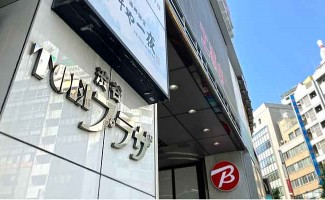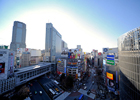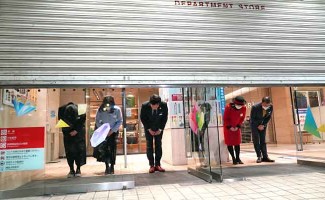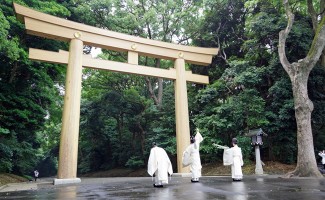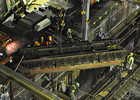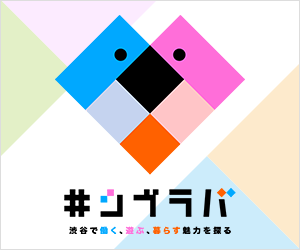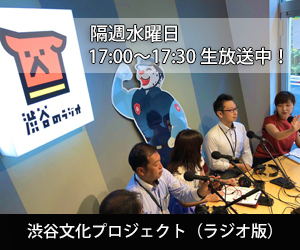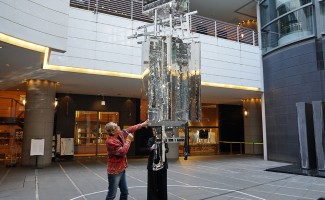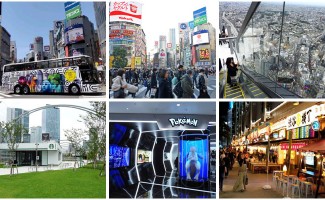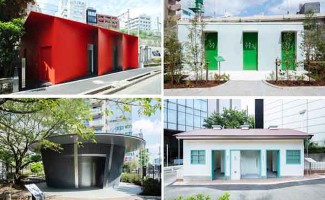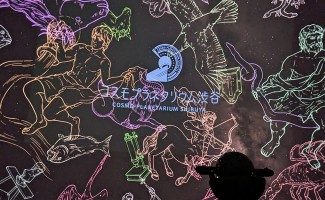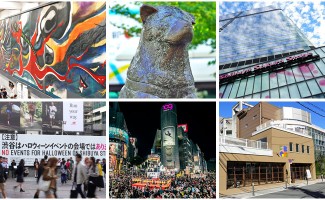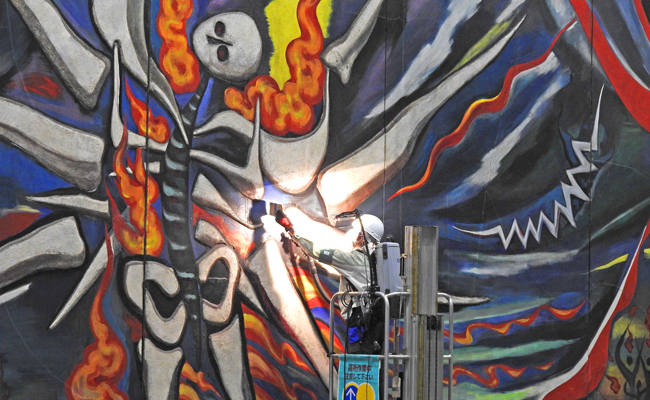
【Report】 10th year from release, Taro Okamoto "Myth of tomorrow" Midnight behind the scenes of the payment
“Sushi” is one of the traditional events in Japan that removes dust and dirt accumulated in a year, cleanses the evil of that year, and welcomes the New Year. It feels like a practice far from Shibuya, but in fact it is not here in Shibuya, and there is a "sushi payment" that takes place once a year. Cleaning activity of Taro Okamoto's huge mural "Tomorrow Mythology" open to the public in the communication passage of SHIBUYA MARKCITY connecting JR Shibuya Station with Keio INOKASHIRA LINE More than 300,000 people are passing every day As we pass through here, trash and dust that flies in the air stick to the mural. It has been open to the general public in Shibuya on November 17, 2008, and this fall for 10 years. From the next year, "Sususou" will be released once a year by the hands of volunteers such as companies and shopping districts in Shibuya, city residents and Okamoto Taro fans around NPO corporation "Mythology Conservation and Inheritance Organization of Tomorrow" from the next year. It will be the ninth year this year.
However, considering the obstruction of traffic from being facing general public roads, it is done late at night from the last train to the first train. For this reason, few people see the scenery of "soot pays".
This autumn was held on 26th and 27th October and 2nd and 3rd November over 50 days, with 50 volunteers participating. I will report on the state of the clean-up activities and report on the unknown behind-the-scenes appearance of the "myth of tomorrow" soot payment.
| After the last train, "Susuwaki" starting in the communicating path that got quiet!
A busy Shibuya station on the weekend, late at night on November 2nd (Friday), the third day of the Susetsu Pay. Work started after 1:00 am when I saw off the last train on the Keio- INOKASHIRA LINE .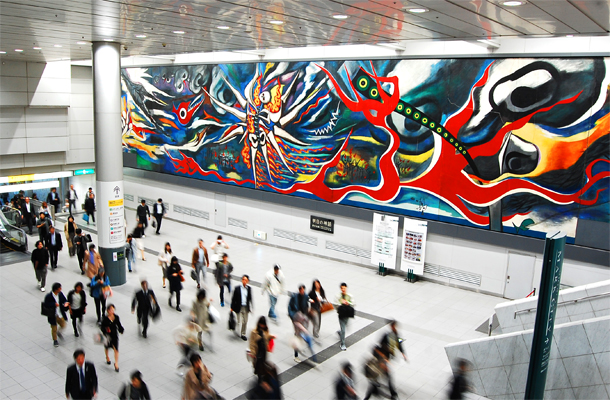 ▲ People heading to the station quickly before the last train
▲ People heading to the station quickly before the last train
The same aisle in front of a mural painting is a general public road where about 300,000 people go and go. In order to prevent the passage of pedestrians and avoid dangers, the actual cleaning work can be done 3 hours net after the last train to 4 AM before the first train. Because it is a gigantic wall painting as large as 30 meters wide and 5.5 meters high, the work does not end on a day, but it lasts over 10 hours in total for the whole 4 days.
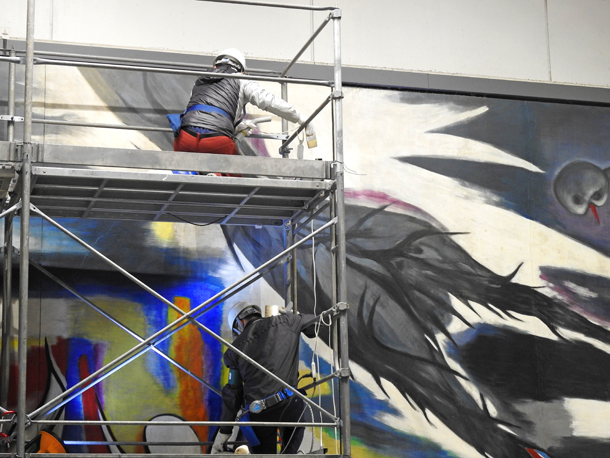 First of all, we organized a 3-stage scaffold on a gigantic mural, divided into 42 blocks in total consisting of 14 blocks in length and 3 upper, middle and lower blocks, and progressively planned cleaning at about 10 blocks a day. In this cleaning activity, I participated in the restoration project of "myth of tomorrow", and in addition to painter restorationist Yoshimura Eimitome who was involved in restoration even after opening, people working in general citizen, local shopping district, Shibuya company etc. Approximately 50 volunteers focused on participated.
First of all, we organized a 3-stage scaffold on a gigantic mural, divided into 42 blocks in total consisting of 14 blocks in length and 3 upper, middle and lower blocks, and progressively planned cleaning at about 10 blocks a day. In this cleaning activity, I participated in the restoration project of "myth of tomorrow", and in addition to painter restorationist Yoshimura Eimitome who was involved in restoration even after opening, people working in general citizen, local shopping district, Shibuya company etc. Approximately 50 volunteers focused on participated.
| "When I come here I feel that the year is about to end (laugh)"
Osawa Yoshikazu, an office worker who will participate for nine consecutive years, will reveal its driving force.
"In about Taro Okamoto Memorial Hall in Okamoto Taro Memorial Hall, I came across to Mr. Toshiko Okamoto at (Taro Okamoto Memorial) around 2003. After Toshiko's death, I was volunteered with feeling that I was baton-touching after Toshiko's death In the meantime, I felt it was really nice to have been able to continue with various things while having it, "I look back over the last 10 years with a deep emotion.
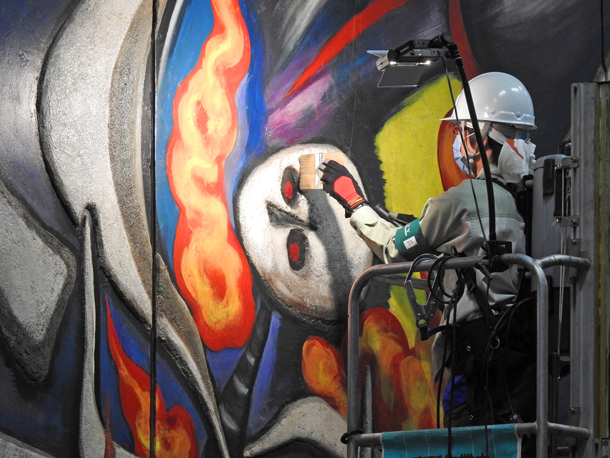 ▲ Mr. Ozawa carefully cleaning the "skeleton" part of the center
▲ Mr. Ozawa carefully cleaning the "skeleton" part of the center
"When I look at it from a distance, the mural painting seems to be flat, but as I clean it, the irregularities and subtle details become clearly visible, it is a painting rather than a painting, I understand well that it is a relief," When this comes, I feel that the year will end soon. " For Ozawa, it seems that the "soot pays" volunteer has been established as a once-in-a-lifetime poetry.
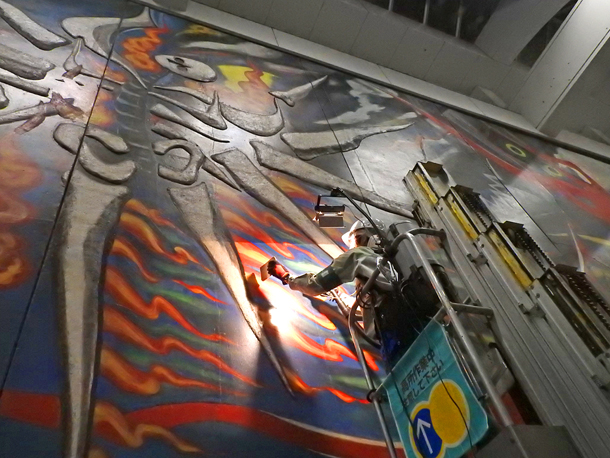 This time Ozawa takes a lifter and is in charge of cleaning the "skeleton" part of the "central part of" tomorrow 's myth. Leave the helmet on your head, always wear safety belts on your waist, in addition to masks and gloves, as well as work on a scaffold that can reach about 4 to 5 meters in height. While facing each other with a distance feeling of about 30 centimeters from the mural painting, "cosmetic dust" deposited on the surface of the picture is drawn off with "brush". The thing to be aware of at this time is that "it is within the reach of the eyes, taking a look closely at the screen and taking dust with a small" brush "."
This time Ozawa takes a lifter and is in charge of cleaning the "skeleton" part of the "central part of" tomorrow 's myth. Leave the helmet on your head, always wear safety belts on your waist, in addition to masks and gloves, as well as work on a scaffold that can reach about 4 to 5 meters in height. While facing each other with a distance feeling of about 30 centimeters from the mural painting, "cosmetic dust" deposited on the surface of the picture is drawn off with "brush". The thing to be aware of at this time is that "it is within the reach of the eyes, taking a look closely at the screen and taking dust with a small" brush "."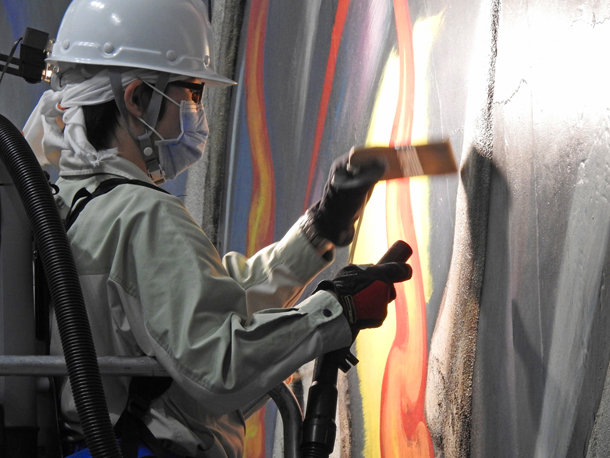 ▲ It is the basic style to carry a vacuum cleaner on the back, "brush" on the left hand, "nozzle of the vacuum cleaner" on the right hand paying the soot
▲ It is the basic style to carry a vacuum cleaner on the back, "brush" on the left hand, "nozzle of the vacuum cleaner" on the right hand paying the soot
In the unlikely event that "paint" will be peeled off or damaged at the time of work, we will dust off with "brush", and at the same time all the dust and dirt will be completely absorbed by the vacuum cleaner held in the other hand . Also, in order to guess which "paint" fell from where, when cleaning with a vacuum cleaner it is necessary to exchange garbage pack every 1 to 14 blocks, not just cleaning, but polite and careful work assuming restoration Desired. Especially in a high place not reachable by the scaffold, you must board the "single-lifter lifter" and be in the shape of a vacuum cleaner on the back, reaching about 7 meters from the ground. The steady work by volunteers continued silently at Shibuya station in the midnight when the bustle in the day fell back like a lie.
| "Town" and "People", "People" and "People" are connected with "Power of Art"
"The faithful dog Hachiko statue" Similarly, a giant mural painting "a myth of tomorrow" established as a symbol of "the city of Shibuya". It is displayed in a public place without putting it in a case because we are following the will of Mr. Taro Okamoto, "Art is the masses". On the other hand, concourses with a lot of traffic passengers dance, dangers in temperature and humidity are intense, and it can not be said that this is an environment friendly to the art. In these circumstances, we are preserving and preserving public art, including Shibuya companies, shopping districts, citizens, people who like "the city of Shibuya" and people who adore Tarou, a small one It can be said that gatherings are good intentions.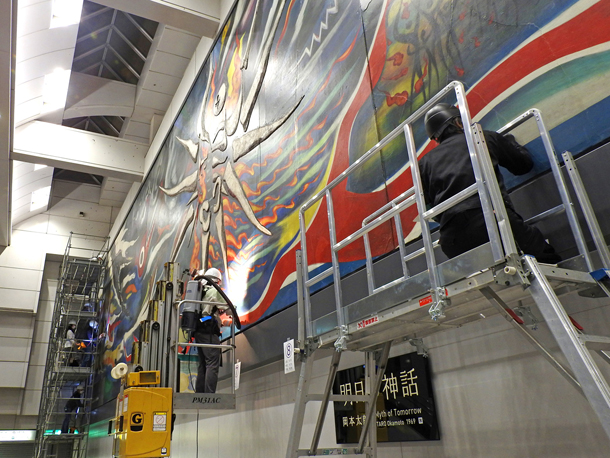 The face of the participants who finished the cleaning after 4:00 am feeling something that is close to refreshing feeling or euphoria obtained when they accomplished something uniformly than tired or sleepy. There are not many people who meet again once a year by "soot pays". "Tomorrow" and "people", "people" and "people" are linked to nature through "myths of tomorrow", and certain communities and networks have been formed over the past decade. The power of art left by Mr. Taro is also evident from the mysterious connection between such volunteers.
The face of the participants who finished the cleaning after 4:00 am feeling something that is close to refreshing feeling or euphoria obtained when they accomplished something uniformly than tired or sleepy. There are not many people who meet again once a year by "soot pays". "Tomorrow" and "people", "people" and "people" are linked to nature through "myths of tomorrow", and certain communities and networks have been formed over the past decade. The power of art left by Mr. Taro is also evident from the mysterious connection between such volunteers.
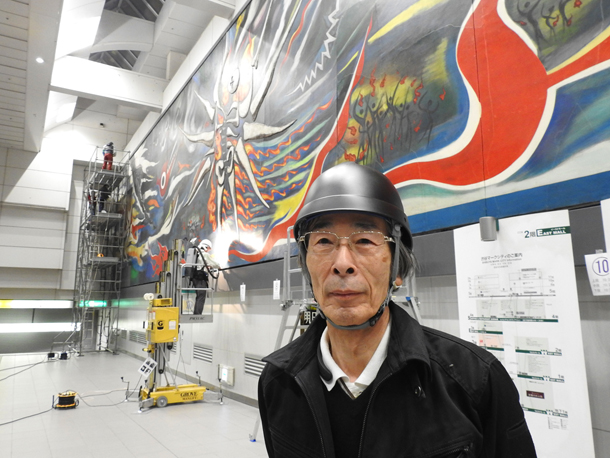 ▲ Painting restorer who was engaged in restoration project "tomorrow's myth" and was involved in restoration after release, Eimi Tsurumi Yoshimura
▲ Painting restorer who was engaged in restoration project "tomorrow's myth" and was involved in restoration after release, Eimi Tsurumi Yoshimura
Painting restorationist Yoshimura Emi - tsumi looks back on the usual 'Susu' payment. "I believe that supporting volunteers with public art volunteers is unprecedented in Japan and I think this is going very well, compared to 10 years ago, there are some stains on the surface, but the original works themselves There is not a big problem in the situation, "he said, highly appreciating the cleaning activities of the past 10 years.
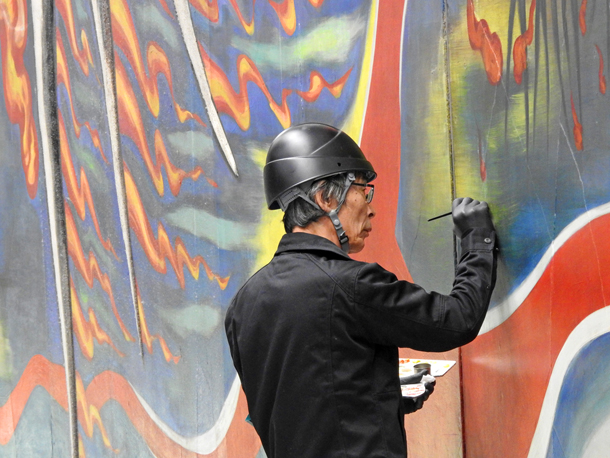 Regarding the maintenance of mural painting in the future, Mr. Yoshimura said, "Since the temperature in the summer is high and the rainfall is large in the typhoon this year, more dust has adhered than usual, especially dust including humidity gets stuck, There was something, "worried about the effect of humidity and summer heat on mural paintings.
Regarding the maintenance of mural painting in the future, Mr. Yoshimura said, "Since the temperature in the summer is high and the rainfall is large in the typhoon this year, more dust has adhered than usual, especially dust including humidity gets stuck, There was something, "worried about the effect of humidity and summer heat on mural paintings.
Ahead of the tenth anniversary from the public release that will celebrate the 17th of this month, 4 days of "soot pays" has ended. The accumulated "cotton bokori" was cleanly removed, and the vivid color of the work has revived. If there is a chance to go ahead of "the myth of tomorrow", please stop stopping at me again.
From Mexico to Shibuya - "A myth of tomorrow" followed by a fateful fate
The biggest work among the paintings left by the artist Taro Okamoto (1911-1996). On March 1, 1954, the theme of the tuna fishing boat "The 5th Fukuryuru Maru" that was bombed by rice / hydrogen explosion experiment is drawing the moment when the atomic bomb cracks. It was around 1968 to 1969 that it was produced. Although it was drawn to decorate in the lobby of a newly built hotel which was planned to be built in Mexico, due to deterioration in the management condition of the client, the hotel will be handed over to the unfinished state. Although the location of the mural painting was unknown after that, it was discovered in a disastrous appearance in the material storage space of the suburbs of Mexico in September 2003 after more than 30 years passed. Late · Tomoko Okamoto's centering on "myth of tomorrow" regeneration project was established, restoration work was carried out for 1 year from July 2005. "Shibuya Ward" is decided as a permanent installation destination after the special release at Shiodome and Tokyo Metropolitan Museum of Contemporary Art since 2006. From 17th November 2008, public release began in the communication passage of SHIBUYA MARKCITY .

Editorial department · Fuji Itakashi
Shibuya registrar. In addition to Shibuya of Culture information, seasonal news and topics, it will spell write that feel every day.
